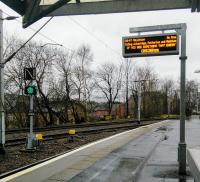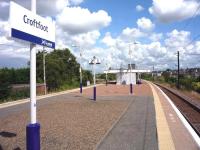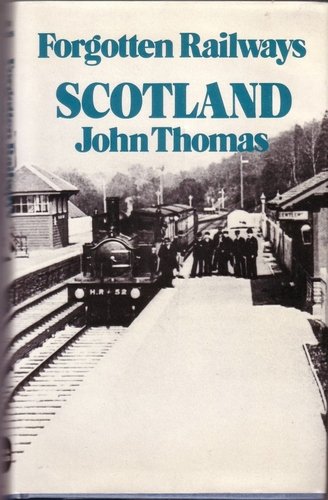Lanarkshire and Ayrshire Railway
Introduction
This line is closed, save for sections between Neilston and Cathcart (used by electric passenger trains), Cathcart and Newton (used by electric passenger trains and diverted trains), a siding north of Lugton (occasionally used by fertiliser freight trains), Lugton to RNAD Beith (used to deliver Government supplies to and from the site; the line has not been used for some time) and sidings at Stevenston (for the Stevenston and Ardeer works; these sidings are now out of use). Much of the closed length of the line remains walkable. A pipeline has been laid buried in the trackbed at Uplawmoor [1st]. Many of the works associated with the line were built in concrete and remain intact. The line was a protege of the Caledonian Railway and was intended to compete with the existing Glasgow and South Western Railway services on the parallel former Glasgow, Paisley, Kilmarnock and Ayr Railway.
Why built
Initially the locally promoted Barrmill and Kilwinning Railway was to be a link between existing lines; the Glasgow and South Western Railway's Ardrossan-Glasgow line and the jointly owned Glasgow and Kilmarnock Joint Railway.
With Caledonian Railway backing its intent expanded to include an independent route from the port at Ardrossan through to the Lanarkshire coalfield, iron works and steel works. In addition the steamer trade from Ardrossan to Arran would be pursued.
Iron ore began to be imported in quantity from Spain in the 1870s as local supplies were either worked out or unable to supply the increasing number of works. This line would put ownership of the route from Lanarkshire to Ayrshire under single ownership. It started to be eclipsed with the opening of the Rothesay Dock Branch (North British Railway and Caledonian Railway) in 1907.
The Caledonian, through its subsiduary the Caledonian Steam Packet Company, operated steamers from Ardrossan to Arran's piers.
Despite being run down increasingly from the 1920s the line was busy with night time ambulance trains from Ardrossan to Glasgow and explosives traffic (there were several sites served) during the Second World War.
Service
There are two passenger services. Electric trains run to Neilston from Glasgow Central (High Level) via Queens Park. Additionally electric trains run to Newton from Glasgow Central (High Level) via Shawlands.
Dates
Route described
The line runs from the junction with the Hamilton branch at Newton through Cathcart and on to Neilston, Giffen (branch to Kilbirnie), Kilwinning (branch to Irvine) and finally Ardrossan.
Portions of line and locations
This line is divided into a number of portions.
Barrmill to Ardrossan
Opened in 1888 from Barrmill Junction to Ardrossan Montgomerie Pier.
The Lanarkshire and Ayrshire Railway line, opened 1888, started from here from the Beith Town branch of the Glasgow and Kilmarnock Joint Railway of 1873 and ran south west to Ardrossan Montgomerie Pier. The junction was immediately east of Barrmill station.
...
See also
Glasgow and Kilmarnock Joint Railway
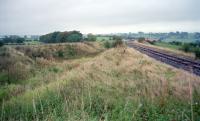
Ewan Crawford //1996
This junction did not exist on the 1890 Ardrossan Montgomerie Pier to Barrmill Junction line. The Caledonian Railway, having control over the Lanarkshire and Ayrshire Railway, was keen to own entirely a route to Ardrossan. From Barrmill Junction to Langside Junction the line was jointly owned with the Glasgow and South Western Railway.
...

Bill Roberton //1992

Ewan Crawford //1997

Ewan Crawford 07/10/2006
Owned by Barr Coal Co. ...
More detailsThis was a four platform station. There were two main platforms on the Giffen Junction to Kilwinning East main line and also two on the Kilbirnie (South) branch. However, there were two tracks between the main platforms and only one between the branch platforms. The branch down side was the west face of the island platform whose east side served the up main line. The branch up side ...
More details
Colin Kirkwood 10/04/1966

Ewan Crawford 17/08/2017

G H Robin collection by courtesy of the Mitchell Library, Glasgow 09/06/1962

G H Robin collection by courtesy of the Mitchell Library, Glasgow 09/06/1962
At this junction the Kilbirnie (South) branch (1889) left the Lanarkshire and Ayrshire Railway main line (1888). Giffen station was immediately north east of the junction.
...

Bill Roberton //1992

K A Gray 09/06/1964

Andy Carr Collection 10/04/1966
This was a two platform station. The main station building was on the southbound platform with a waiting shelter on the northbound.
...
This goods yard was between Auchenmade and Kilwinning East. The sidings were on the east side of the line, approached from the north, from the northbound line across the southbound. There was one siding by the main lines and a pair to the east. There was a signal box on the west side, opposite the turn out.
...
This seven arch double track masonry viaduct was built in 1886 by Robert McAlpine to cross the River Garnock.
...

Ewan Crawford 14/09/2017
This was a three platform station with a junction to the south between the lines to Ardrossan Montgomerie Pier and Irvine Bank Street.
...

Ewan Crawford //1996
This junction was immediately south of Kilwinning East station, separated from it by the Howgate Bridge. It was located in a deep cutting with a large concrete retaining wall on the west side, which remains although only the top part is visible today.
...

Douglas Blades //2017

Ewan Crawford 07/09/2017

Douglas Blades 13/09/2017

Douglas Blades 31/03/2019
At this junction a curve from the Ardeer Iron Works met the Lanarkshire and Ayrshire Railway. The curve met an existing line serving the works. Trains using this connection would leave the works and head for Kilwinning East.
...

Ewan Crawford 03/08/2017
This was a two platform station to the west of New Street which was crossed by a bridge. The main station building was on the eastbound platform.
...
This was a two platform station to the north of the present Saltcoats station. This station was built by the Lanarkshire and Ayrshire Railway (which was controlled by the Caledonian Railway) in direct competition with the existing Glasgow and South Western Railway station. This station was to the north of Saltcoats and its harbour.
...
This was a four road shed. It was located east of Ardrossan North on the north side of the line. The shed opened with the line and closed in 1931, although used for storage until 1953. Displaced locomotives were assigned to Ardrossan Shed [GSW] [2nd] in 1931. Even after closure a track retained here was used for holding locomotives.
...
This was the goods yard for Ardrossan North it was located on the east side of the line, north of the station. Approach was from the east.
...

Ewan Crawford //1987
This refinery was opened in the 1928. Raw material came by sea and products were distributed by rail. By the 1970s the works specialised in bitumen production, having previously also produced aviation fuel. The works closed in 1986.
...
This was a large station in the north of Ardrossan. The last of the site has been reused for housing (2017). This station was built in competition with the Glasgow and South Western Railway's Ardrossan Town station in the south of the town. It was built on reclaimed land of the North Bay. Similar substantial station buildings built in timber containing offices, waiting rooms etc could be ...
More details
Ewan Crawford //1987

Ewan Crawford 10/08/2017

G H Robin collection by courtesy of the Mitchell Library, Glasgow 05/07/1959

G H Robin collection by courtesy of the Mitchell Library, Glasgow 24/05/1960
This signal box was located between Ardrossan Winton Pier and Ardrossan Town at Ardrossan Harbour Junction. It survived the closure of most of the signal boxes in Ayrshire, massive cut back in sidings it had controlled, and the electrification of the railway to Ardrossan Harbour.
...
This two platform terminus was covered with a wooden trainshed, open to the air over the tracks. The station was located on a pier, which could be used at low tide, built on reclaimed land. There were quayside lines on both sides.
...

G H Robin collection by courtesy of the Mitchell Library, Glasgow 14/08/1964

G H Robin collection by courtesy of the Mitchell Library, Glasgow 14/08/1964

Gordon Steel 31/05/1972

K A Gray 10/04/1966
Ardeer Iron Works Branch
This branch opened in 1888. It served the Ardeer Iron Works and, by reversal, the Nobel Explosives branch.
At this junction a curve from the Ardeer Iron Works met the Lanarkshire and Ayrshire Railway. The curve met an existing line serving the works. Trains using this connection would leave the works and head for Kilwinning East.
...

Ewan Crawford 03/08/2017
This iron works was established by the Glengarnock Iron Company on the shore of the Ardeer Peninsular just to the south of Stevenston. Good supplies of coal existed in the area. Five blast furnaces were built. Slag was deposited on the foreshore, leading to a still existing feature. The works was later owned by Merry and Cunningham. Also known as Stevenston Iron Works.
...
See also
Glengarnock Iron Company
Kilbirnie Branch
Opened in 1889. This branch re-used an extensive portion of an older railway, the Barkip Railway which was operated in conjunction with the Glengarnock Iron Works. Brackenhills station was on the converted section. Kilbirnie Junction to Barkip Junction was a new section as was north of Gurdie Sidings and on the Glengarnock and Kilbirnie.
At this junction the Kilbirnie (South) branch (1889) left the Lanarkshire and Ayrshire Railway main line (1888). Giffen station was immediately north east of the junction.
...

Bill Roberton //1992

K A Gray 09/06/1964

Andy Carr Collection 10/04/1966
RNAD Beith, a munitions depot, was built during the Second World War in 1943. It is a storage and testing location.
...
This junction was on the Kilbirnie branch of the Lanarkshire and Ayrshire Railway. A large part of this branch predated the L&A and had begun life as a mineral line, the Barkip Railway, which ran south from the Glengarnock Iron Works.
...
See also
Barkip Railway

Ewan Crawford //1997

Douglas Blades 08/01/2018
Although the Kilbirnie (South) branch was single track, this was a two platform station. To the north the line continued double to the terminus at Kilbirnie (South) and to the south it was single to Kilbirnie Junction. The main station building was on the southbound platform with a waiting room opposite. A signal box was at the south end of the northbound platform.
...
This was the Caledonian Railway's 1889 terminus in the east of Kilbirnie. It was approached from Glengarnock [CR] by a double track line, beyond Glengarnock it was a single track branch to Giffen on the main line of the Lanarkshire and Ayrshire Railway.
...
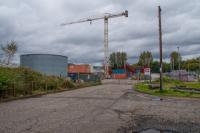
Ewan Crawford 28/09/2017

Ewan Crawford //1987
Irvine Branch
The Irvine branch was single track and ran from Kilwinning East to Irvine Bank Street. It opened in 1890. Only the down track was laid but most bridges were built to accommodate a second track if traffic increased.
This junction was immediately south of Kilwinning East station, separated from it by the Howgate Bridge. It was located in a deep cutting with a large concrete retaining wall on the west side, which remains although only the top part is visible today.
...

Douglas Blades //2017

Ewan Crawford 07/09/2017

Douglas Blades 13/09/2017

Douglas Blades 31/03/2019
This was a three platform station with a junction to the south between the lines to Ardrossan Montgomerie Pier and Irvine Bank Street.
...

Ewan Crawford //1996
This iron works was located to the south of Kilwinning on the west bank of the River Garnock. It made use of the nearby collieries.
...
See also
Eglinton Iron Company Railway

Ewan Crawford 07/09/2017

Ewan Crawford 14/09/2017

Douglas Blades //2017
A slag processing area which processed the slag hill at the former Eglinton Iron Works.
...
This was a single platform station - the platform was on the east side of the line a siding, approached from the north, was on the west. The line was built to take two lines, but on the down track was laid.
...

Ewan Crawford //1998
This was a single platform terminus. It was the terminus of the Caledonian Railway's Lanarkshire and Ayrshire Railway line south from Kilwinning East which potentially could be have been extended south to Ayr. The terminus was located on the east side of the town centre.
...

Ewan Crawford //1998

Andy Furnevel 10/12/2015

Ewan Crawford //1997

Andy Furnevel 10/12/2015
Clarkston East Junction to Giffen Junction
This line opened in 1903. This extended the line east to Clarkston East Junction, parallel to the joint line.
This was a short lived junction between 1903 and 1907. The Lanarkshire and Ayrshire Railway reached Cathcart (for passengers) and Clarkston East Junction (for minerals) from Ardrossan in 1903.
...
See also
Busby Railway

G H Robin collection by courtesy of the Mitchell Library, Glasgow 25/05/1964

G H Robin collection by courtesy of the Mitchell Library, Glasgow 31/01/2020

G H Robin collection by courtesy of the Mitchell Library, Glasgow 26/05/1962

John Robin 08/04/1963
In 1903, the Lanarkshire and Ayrshire Railway was extended from Giffen Junction to Clarkston and, a month later, Cathcart. At this junction the Clarkston and Cathcart routes separated. This junction was the start of the passenger route to Glasgow via Cathcart and a curve to Clarkston East Junction which carried goods to and from Lanarkshire via East Kilbride before the ...
More detailsThis is one of the finest stations in the Greater Glasgow area. It is a two platform station. The main station building on the up platform still stands. Unfortunately the down platform building and signal box, opened with the station, have not survived.
...

Peter Mckinlay //2015

Peter Mckinlay 08/06/2017
This is a two platform station with a car park. Unfortunately the buildings, which were similar to those at Whitecraigs, have not survived.
...

David Panton 22/06/2019

David Panton 04/03/2017

G H Robin collection by courtesy of the Mitchell Library, Glasgow 08/09/1960

David Panton 28/07/2008
This was to be a station with an island platform. To the immediate west the Lanarkshire and Ayrshire Railway was met by the Paisley and Barrhead District Railway at Lyoncross Junction.
...

G H Robin collection by courtesy of the Mitchell Library, Glasgow 08/09/1960
This junction was immediately west of the never completed Lyoncross station. The signal box was at the west end of its never built island platform and opened with the junction in 1905.
...
See also
Paisley and Barrhead District Railway

Network Rail /08/2023

Ewan Crawford 14/09/2017

Network Rail /08/2023
This goods yard was located between Neilston and Lyoncross Junction at a rural location.
...

Ewan Crawford 28/09/2017
This is a two platform terminus station. To the south the two lines of the railway merge at a reversing spur. Although the Caledonian Railway style station buildings were demolished in the late 1980s the goods shed survives. The larger building with ticket office was on the Glasgow bound platform with a smaller building on the southbound platform.
...

Brian Haslehust 28/02/1965

Brian Haslehust //1969

Brian Haslehust //1977

...
Bill Roberton 24/09/2019
This was a two platform station in typical Lanarkshire and Ayrshire Railway style of the Caledonian Railway.
...
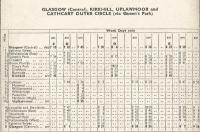
David Panton 12/09/1960

G H Robin collection by courtesy of the Mitchell Library, Glasgow 15/06/1961

Ewan Crawford //1999
This was a double track junction north of Lugton High station. It was the junction between the Lanarkshire and Ayrshire Railway and its connection to Lugton on the Glasgow and Kilmarnock Joint Railway.
...

G H Robin collection by courtesy of the Mitchell Library, Glasgow 17/05/1960

G H Robin collection by courtesy of the Mitchell Library, Glasgow 15/06/1961

Ewan Crawford //1996

G H Robin collection by courtesy of the Mitchell Library, Glasgow 21/03/1962
This was a two platform station. It was to the south of Lugton station (which was on the Glasgow and Kilmarnock Joint Railway).
...

Ewan Crawford //1996

Ewan Crawford 03/08/2017

Ewan Crawford 03/08/2017

Ewan Crawford //1996
A double track eleven arch viaduct built by Robert McAlpine in concrete. After falling out of use in 1950, the viaduct survived until February 2008 when it was demolished.
...

Bill Roberton //1989

Ewan Crawford //1989
This goods yard was on the south side of the line, approached from the west. It consisted of three sidings and a loading bank in a cutting. Gree Farm is to the east.
...

Ewan Crawford 28/09/2017
This was a double track seven span double track mass concrete viaduct built by Robert McAlpine.
...

Ewan Crawford 07/10/2006
This junction did not exist on the 1890 Ardrossan Montgomerie Pier to Barrmill Junction line. The Caledonian Railway, having control over the Lanarkshire and Ayrshire Railway, was keen to own entirely a route to Ardrossan. From Barrmill Junction to Langside Junction the line was jointly owned with the Glasgow and South Western Railway.
...

Bill Roberton //1992

Ewan Crawford //1997

Ewan Crawford 07/10/2006
Lugton East Junction to Lugton L and A Junction
This short connection opened in 1903 to meet the joint line. A number of sidings opened with the connection.
This was a double track junction north of Lugton High station. It was the junction between the Lanarkshire and Ayrshire Railway and its connection to Lugton on the Glasgow and Kilmarnock Joint Railway.
...

G H Robin collection by courtesy of the Mitchell Library, Glasgow 17/05/1960

G H Robin collection by courtesy of the Mitchell Library, Glasgow 15/06/1961

Ewan Crawford //1996

G H Robin collection by courtesy of the Mitchell Library, Glasgow 21/03/1962
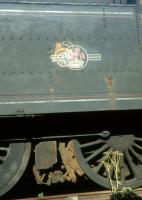
Colin Kirkwood 15/09/1963

G H Robin collection by courtesy of the Mitchell Library, Glasgow 15/06/1961

G H Robin collection by courtesy of the Mitchell Library, Glasgow 10/05/1951

G H Robin collection by courtesy of the Mitchell Library, Glasgow 09/06/1962
Lugton L&A Junction opened in 1903 between the 1871 Glasgow and Kilmarnock Joint Railway, (jointly owned by the Caledonian Railway and Glasgow and South Western Railway), and the extension of the Lanarkshire and Ayrshire Railway opened in 1903 between Giffen Junction and Cathcart West Junction. The L&A junction opened as part of a short link joining the new line at [[Lugton ...
More detailsSee also
Glasgow and Kilmarnock Joint Railway
Cathcart West Junction to Clarkston West Junction
This opened in 1903 and extended the line east from Clarkston West Junction to Cathcart West Junction.
This is a four way junction. Two lines of the Cathcart Circle from Glasgow Central, one via Crosshill and via Maxwell Park, meet a line from Neilston and a line from Newton. The junction allows a train via Crosshill to run to Neilston and a train via Maxwell Park to run to Newton. Unfortunately the latter passes close to Cathcart but does not serve it.
...
See also
Cathcart District Railway

David Panton 14/07/2021

Ewan Crawford //

John McIntyre 10/01/2019
Muirend is one of the finest stations in the Glasgow area. It is an island platform with its original building and broad cantilevered canopies, the only intact survivor of its type.
...

Network Rail /09/2022

John Furnevel 06/05/2007
This is a two platform station built on the site of Clarkston West Junction. ...
More details
David Panton 07/07/2018

David Panton 07/07/2018

...
John Steven 22/05/2009
In 1903, the Lanarkshire and Ayrshire Railway was extended from Giffen Junction to Clarkston and, a month later, Cathcart. At this junction the Clarkston and Cathcart routes separated. This junction was the start of the passenger route to Glasgow via Cathcart and a curve to Clarkston East Junction which carried goods to and from Lanarkshire via East Kilbride before the ...
More details
Muirend to Clarkston East Junction
This curve was built but was only used as carriage sidings from the Muirend station end.
Muirend is one of the finest stations in the Glasgow area. It is an island platform with its original building and broad cantilevered canopies, the only intact survivor of its type.
...

Network Rail /09/2022

John Furnevel 06/05/2007
To the south of Muirend station was the north end of the intended curve from here to Clarkston East Junction on the East Kilbride line. The double track was converted into two long carriage sidings in 1907, approached from Muirend. This was a very long chord, which ran parallel to the Neilston route for around 0.8 of a mile before turning away to the south east.
...
This was a short lived junction between 1903 and 1907. The Lanarkshire and Ayrshire Railway reached Cathcart (for passengers) and Clarkston East Junction (for minerals) from Ardrossan in 1903.
...
See also
Busby Railway

G H Robin collection by courtesy of the Mitchell Library, Glasgow 25/05/1964

G H Robin collection by courtesy of the Mitchell Library, Glasgow 31/01/2020

G H Robin collection by courtesy of the Mitchell Library, Glasgow 26/05/1962

John Robin 08/04/1963
Newton Junction to Cathcart West Junction
This extension east opened in 1904. This extended the line from Cathcart West Junction to Newton West Junction. Opening this was the beginning of the end for the goods only Clarkston West Junction to Clarkston East Junction curve.
Newton West Junction is to the west of Newton station. It is where lines divide into the bypass lines, to the north, and platform lines, to the south. The platform lines are joined by the line from Kirkhill, to the south west, as they approach the station. This location is called Newton Kirkhill Junction although it used to come under Newton West Junction.
...
See also
Clydesdale Junction Railway
Hamilton Branch (Caledonian Railway)

Colin McDonald 10/12/2015

Colin McDonald 10/12/2015

Colin McDonald 28/08/2015
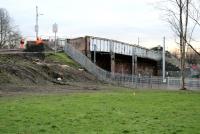
Colin McDonald 05/02/2015
To the immediate west of Newton the former Clydesdale Junction Railway and Lanarkshire and Ayrshire Railway part and run a short distance west before diverging.
...
See also
Hamilton Branch (Caledonian Railway)
This junction was east of Kirkhill station and Kirkhill Tunnel. Here the line from Ardrossan North (and today from Neilston) divided into routes to Newton and Carmyle. The junction was in a cutting directly east of the tunnel.
...
See also
Glasgow Central Railway
This station is west of Kirkhill Tunnel. It is a two platform station. It had platform waiting rooms (which still stood after electrification) and a street level ticket office, which survived the platform buildings but was demolished in the 1990s (?). The platforms are much lower than the surrounding land.
...

John McIntyre 03/09/2021

David Panton 26/02/2020
This is an island platform station. The line is raised and the entry is by subway, with a rather fine archway entrance to the subway at street level. This was covered over with an oversize Burnside sign for many years, but has now been uncovered again. The original station building has not survived. At the east end of the station two bridges cross Burnside Road, the southern of which carried two ...
More details
John McIntyre 03/09/2021

John Furnevel 15/04/2007

David Panton 20/06/2018
This is an island platform station. There is no car park. The station is on a raised embankment, accessed by a subway. The station building is relatively modern and has awnings.
...

John McIntyre 03/09/2021
This is an island platform station which still has an original station building.
...

John McIntyre 03/09/2021

David Panton 19/05/2018
This is a double track junction where lines of the Lanarkshire and Ayrshire Railway meet between Cathcart and Newton. The junction was formed in 1904.
...
This double track viaduct carries the former Lanarkshire and Ayrshire Railway over the White Cart Water with an elegant single arch. Although a concrete bridge it is faced with sandstone.
...
This is a four way junction. Two lines of the Cathcart Circle from Glasgow Central, one via Crosshill and via Maxwell Park, meet a line from Neilston and a line from Newton. The junction allows a train via Crosshill to run to Neilston and a train via Maxwell Park to run to Newton. Unfortunately the latter passes close to Cathcart but does not serve it.
...
See also
Cathcart District Railway

David Panton 14/07/2021

Ewan Crawford //

John McIntyre 10/01/2019
Cathcart East Junction to Cathcart North Junction
This pair of single track curve link the Cathcart District Railway at Mount Florida, Cathcart North Junction, to [King's Park]], Cathcart East Junction.
This is a double track junction where lines of the Lanarkshire and Ayrshire Railway meet between Cathcart and Newton. The junction was formed in 1904.
...
This junction is just south of Mount Florida station. Here the Cathcart District Railway of 1886 is met, on either side, by lines from the Lanarkshire and Ayrshire Railway of 1904. Of the 1904 lines the south east bound line simply runs south and east to Cathcart East Junction, the northbound line burrows under the Cathcart District to reach Cathcart East. It passes under at a ...
More detailsSee also
Cathcart District Railway

David Panton 03/08/2019

Colin Harkins 18/02/2007

G H Robin collection by courtesy of the Mitchell Library, Glasgow 19/04/1957
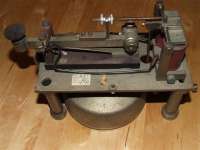
Colin Harkins 18/02/2007
Kirkhill Junction to Westburn Junction
This goods only connection opened in 1904. It ran from Kirkhill Junction, just east of Kirkhill Tunnel, to Westburn Junction on the Lanarkshire and Dumbartonshire Railway. This connection would be useful for Ardrossan traffic to Govan Iron Works and Clyde Iron Works.
This junction was to the south of the Westburn Viaduct. Here the Glasgow Central Railway of 1896 (the portion between Carmyle Junction and Steel Company of Scotland Works Junction, now Newton West Junction) was met by the 1904 Lanarkshire and Ayrshire Railway branch from Kirkhill Junction.
...
See also
Glasgow Central Railway
This junction was east of Kirkhill station and Kirkhill Tunnel. Here the line from Ardrossan North (and today from Neilston) divided into routes to Newton and Carmyle. The junction was in a cutting directly east of the tunnel.
...
See also
Glasgow Central Railway
















